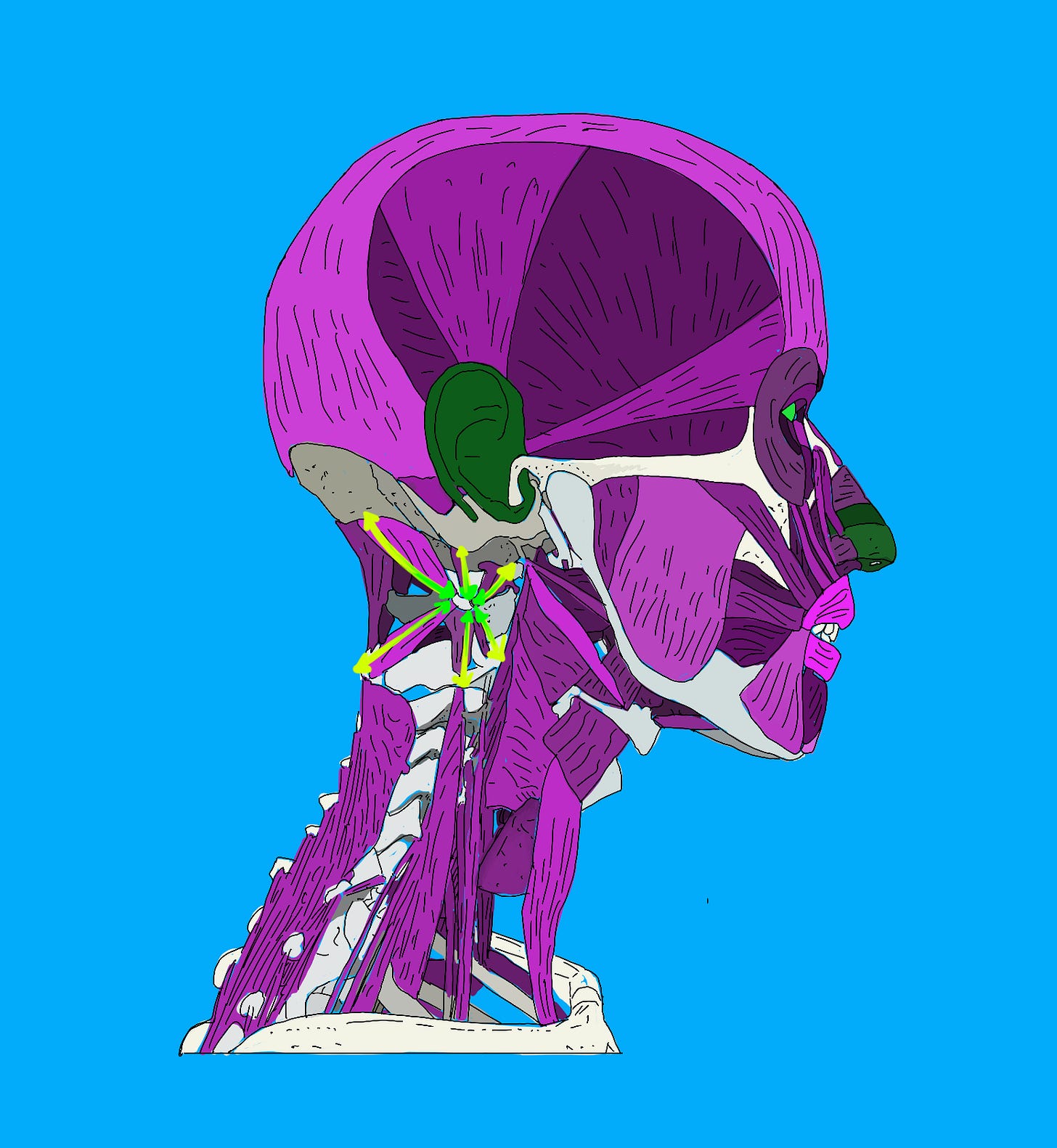The Neck : Sprung Weight
How do I look at these drawings?
Happy Thursday! Boy it’s been a wild ride in the greater world, eh? I didn’t think tariffs and trade deficits would become such a hot topic, but here we are!
All of this chatter takes me back to my college course on the economic theory of taxation. Let me tell you, those discussions were anything but heated. If you’re looking for the book version of a lobotomy, read about tax theory. And if you really are having trouble going to sleep at night, just ask ChatGPT to read the tax code to you.
Zzzzzzzzzzzzz
On to the Goodiessss
Last week I shared 3 drawings that showed the various layers of the muscles of the neck. These drawings did not show you each and every muscle in your neck and are not intended to be some definitive source of anatomical information. Instead, they were made to spark your imagination.
One of the things that can happen to us over the course of our lives is that the muscles can gradually stiffen up. As this stiffening occurs, we very gradually begin to lose the sensation that they are muscles. They begin to feel like solid pieces of marble.
In order to turn these hunks of marble back into fleshy supple muscle, we first have to STOP and recognize that something is not happy within ourselves and is asking for help. You could view this as your Inner Sherlock becoming so overwhelmed with clues that it has to abandon the case it’s on and go for a violin break. At this stage, things may not immediately improve in the musculature, but a very critical question is being asked.
Oftentimes we stop, feel frustrated, and ask for help from someone that says, “Oh I know what the issue is! You should try this simple stretch!”. Maybe this person knows a thing or two, but oftentimes these are bits of advice thrown about at the water cooler at the office by very well intentioned folks. What rarely happens is that we ask ourselves the question, “What is a muscle?”.
In my article You Will Never Know How This Works, I linked to a good YouTube video on the physiological process of contracting and relaxing a muscle. I think it’s worth sharing with you again because the video gives a great explanation of why it’s a very good idea to not know how to relax. That being said, we can learn over time to gently encourage the marble to glacially shift and soften.
This process of learning to not know with the clear wish of transitioning into sprung weight is the real art of the Alexander Technique.
Using the Drawings
When I look at anatomical drawings with muscles, I see how the muscles are organised in relationship to the bones and the other muscles. In some cases, I simply look at the shape of things with blank curiosity. In other cases I begin to see patterns and flows.
Let’s look at two examples based on last week’s drawings.
Example 1 : A starburst of muscle fibers at the back of the neck.
Example 2 : A different starburst pattern of muscles on the sides of the neck
In the two examples above, I have drawn several 2 directional arrows; one end green and the other yellow. If these muscles are in a state of contraction, the muscle length will shorten and the feeling will stiffen. When this happens, the muscle will not feel like a fleshy shock absorbing rubber spring and instead feel like marble. This will kill the spring of the muscle and you won’t feel the expansive arrows drawn above.
If the muscle is experiencing some degree of relaxation or length, then the muscle will expand. How exactly it expands is a mystery, but it will tend to expand along the length of the black lines within the purply areas of the muscles drawn above. This lengthening does not start at one end of the muscles fiber and grow to the other end. Instead it expands in two directions all at once.1
These two states of contraction (or shortening) and relaxation (or lengthening) are perfectly healthy. For certain activities we expect to have some muscles in lengthening and others shortening. For activities like bracing the arms we may feel a whole host of muscles stiffening up. This is all totally fine!
The image of the two directional arrows are simply there to help you imagine what may happen to an area of the neck that is HODL2 and is begging to release. If you can STOP and simply and quietly and clearly imagine the area without the arrows you should expect to sense some vague feeling of change in the musculature. If things are refusing to melt, don’t panic! There are a whole host of other simple things you can check in with to aid the melting process.
I think today’s article is widely applicable to many things, but if you’re looking for a helpful exercise go back to my article on Steering the Head. Imagine that little pirate captain steering your forehead to and fro and see if these images of arrows add anything to your sense of release. When in doubt, remember that you really don’t need to exert any physical effort to make this all happen! The neck muscles will do whatever job they need to do without you forcing them to steer the head.
Get In Touch
If you’re in NYC, you may learn more about my private teaching practice at johndalto.com.
If you’d like to book any lesson time with me, you can find my booking link here.
This description breaks for more unique muscles like the diaphragm.
Hi Mom! This means, “Hold On for Dear Life”.




Thanks for the footnotes!